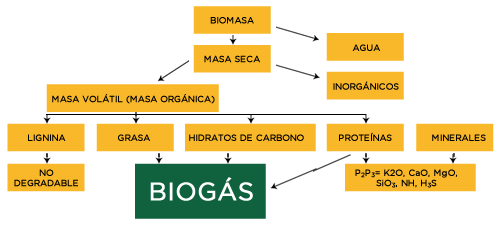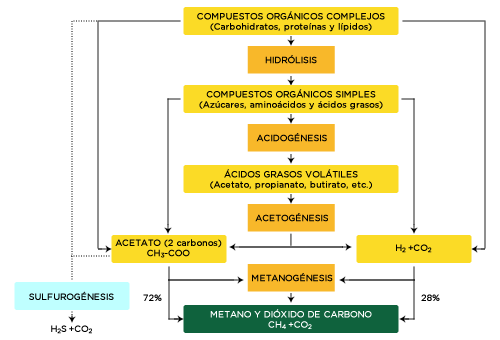OILFOX
Biogas

¿Qué es el Biogas?
El biogás es un gas combustible que se genera en medios naturales o en dispositivos específicos, por las reacciones de biodegradación de la materia orgánica, mediante la acción de microorganismos y otros factores. Este gas suele llamarse “gas de los pantanos”, puesto que en ellos se produce una biodegradación de residuos vegetales semejante a la descrita.
La producción de biogás por descomposición anaeróbica es un modo considerado útil para tratar residuos biodegradables, ya que produce un combustible de valor además de generar un efluente que puede aplicarse como acondicionador de suelo o abono genérico.
La digestión anaeróbica es un proceso biológico complejo y degradativo en el cual parte de los materiales orgánicos de un substrato (residuos animales y vegetales) son convertidos en biogás, (mezcla de dióxido de carbono y metano con trazas de otros elementos) por un consorcio de bacterias que son sensibles o completamente inhibidas por el oxígeno o sus precursores (e.g. H2O). Utilizando el proceso de digestión anaeróbica, es posible convertir gran cantidad de residuos, (vegetales, estiércoles, efluentes de la industria alimentaria y fermentativa, de la industria papelera, FORSU -Fase Orgánica de Residuos Sólidos Urbanos- y de algunas industrias químicas), en subproductos útiles. En la digestión anaerobia más del 90% de la energía disponible por oxidación directa se transforma en metano, consumiéndose sólo un 10% de la energía en crecimiento bacteriano frente al 50% consumido en un sistema aeróbico.
Este gas se puede utilizar para producir energía eléctrica mediante turbinas o plantas generadoras a gas, en hornos, estufas, secadores, calderas u otros sistemas de combustión a gas, debidamente adaptados para tal efecto.


La biomasa representa en la actualidad dos tercios de las energías renovables en Europa y se espera que la bioenergía desempeñe un papel clave en la consecución de los ambiciosos objetivos aprobados por la directiva de energías renovables (COP 21), con la que se pretende abastecer, como mínimo, un 20% de la electricidad generada para el año 2020, cuando actualmente la cuota es muy inferior.
Los objetivos de OIL FOX, para el aprovechamiento del biogás y los fertilizantes orgánicos, son los siguientes:
1) Permitir la correcta identificación y caracterización del potencial del biogás y los fertilizantes orgánicos.
2) Detectar el desarrollo de las mejores soluciones y aplicaciones para el aprovechamiento del biogás y los fertilizantes orgánicos o biofertilizantes.
3) Fomentar la utilización del sistema de biogás y el uso de los biofertilizantes.
Biogás de Digestores (Biodigestión provocada en instalaciones industriales)
Dentro de este tipo se pueden diferenciar tres subgrupos, dependiendo del origen de los sustratos a digerir:
Biogás de Depuradoras de Aguas Residuales
Biogás FORSU (Fracción Orgánica de Residuos Sólidos Urbanos)
Biogás Agroindustrial
En algunos casos se requerirán mezclas (codigestión) para hacer los procesos viables.
De los tipos de biogás anteriores, el más noble y con menor cantidad de impurezas es el obtenido a partir de residuos agroindustriales. No obstante, en los casos donde se usen como substrato los estiércoles y purines pueden aparecer cantidades significativas de sulfuro de hidrógeno en el biogás, que será preciso depurar antes de su aprovechamiento energético
Biogás de depuradoras de aguas residuales
Este biogás se genera a partir de la digestión anaeróbica de los fangos primarios de las plantas de tratamiento de aguas residuales.
Lodos de estaciones depuradoras de aguas residuales urbanas
Lodos de estaciones depuradoras de aguas residuales industriales
BIOGÁS FORSU (Fracción Orgánica de Residuos Sólidos Urbanos).
Este biogás se genera a partir de la fracción orgánica procedente de los RSU
Biogás Agroindustrial
El sector agroindustrial es la principal fuente generadora de subproductos y compuestos orgánicos. Los subproductos y residuos que forman el grupo de las materias primas agroindustriales son los que provienen de:
La agricultura
La pesca
La ganadería
La industria alimentaria
La industria bioenergética
Industrias de biodiesel (subproductos vegetales) industrias de bioetanol (subproductos vegetales) biorrefinerías. Glicerina
Entre estos tipos de materias primas agroindustriales se merece mencionar por su potencial en la producción de biogás las siguientes:
De origen animal:
Purín de cerdo
Estiércol de vaca
Gallinaza
Restos de otras especies
De origen vegetal:
Hierba
Hoja de remolacha
Paja
Trigo
Cultivos energéticos (con una elevada producción de biogás)
Microalgas
De la Industria Alimentaria de origen vegetal: bagazo de la industria cervecera o residuos hortofrutícolas (citrícolas, del olivo y las almazaras, etc)
Excedentes
No conformes
Subproductos de su transformación
Etc
Otros residuos de la Cadena alimentaria: residuos y aceites de gastronomía
De la Industria Alimentaria de origen animal: subproductos de origen animal no destinados al consumo humano.
Residuos cárnicos
Residuos lácteos
Residuos del pescado
El biogás es un combustible formado sustancialmente por los siguientes gases:

